I recently finished reading “Money Magic” by Laurence Kotlikoff. If your not familiar with Kotlikoff, he’s likely the country’s foremost expert on Social Security benefits. He wrote a great book called “Get What’s Yours” that covered all the ins and outs of claiming benefits. In fact, “Get What’s Yours” was so successful, it was cited as a reason that Congress changed the rules for Social Security and got rid of a popular claiming strategy called ‘file and suspend’.
“Money Magic” offers some great, if somewhat unconventional advice. Here are the major points:
#1 – Pay off your mortgage (and other debt)
Like many financial advisors, I was trained to believe that carrying a mortgage made good financial sense for almost anyone. If you can earn 10% per year by investing in stocks, and your mortgage costs a good bit less than that (say 4%) then it’s self evident that you will be better off by using the bank’s capital to invest in stocks.
However, Kotlikoff argues that mortgages are now losers. And he makes some fair points. First, with the recent increases in standard deduction levels, mortgage interest no longer offers a tax benefit for most people.
Second, paying down a mortgage can significantly reduce your overall financial risk. If you have a mortgage and invest in any risky asset, then you essentially have a leveraged position in that risky asset. That means if the value of your risky asset goes up or down, the burden of the debt liability remains the same. Take a look at the chart below and you can see how increasing amounts of leverage can amplify the returns (random in this case) you might experience as an investor:
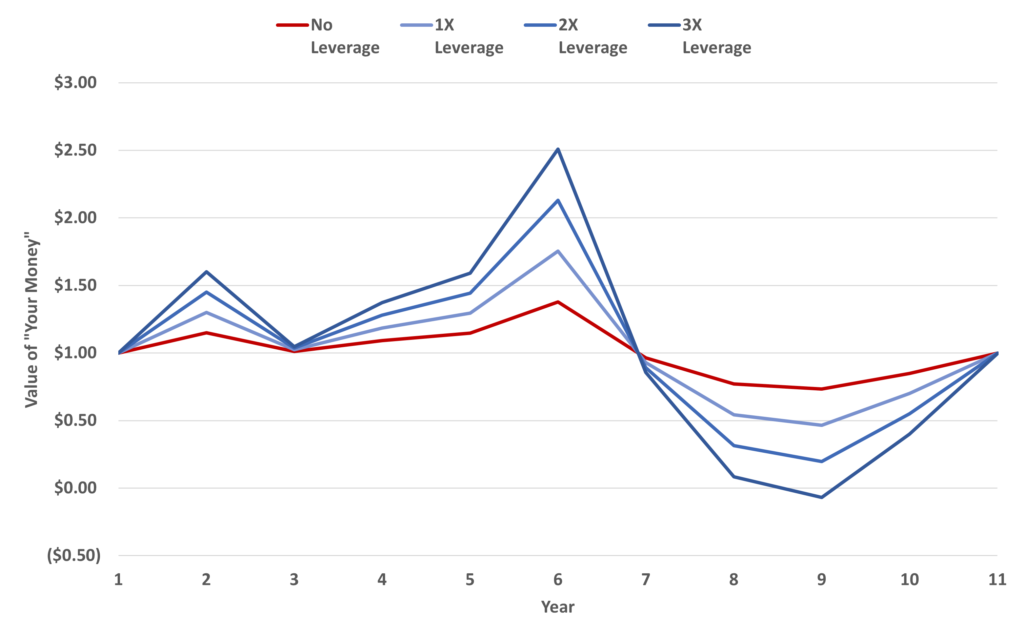
Over the 10 year period, the total return is zero (whether you use leverage or not). But higher levels of debt increase the “roller coaster” effect of your return path. If you use too much leverage, you can go bankrupt as you would have in this example if you used 3X leverage.1
And third, based on historical valuation metrics it’s quite possible that returns on risky assets will be lower for the next few years (see here). Obviously, my crystal ball remains foggy, so I can’t predict the future, but if stock market returns are lower, then paying off your mortgage becomes more attractive.
Asymmetric risk in retirement
For retirees especially, less debt is key. Retirees do not have as much human or career capital as the younger crowd, so it can be much harder to come back from a run of bad luck. Even very wealthy families can put themselves in real trouble by taking on too much debt and investing too aggressively.
The fact is investment risk for retirees can be asymmetric. If the stock market goes up a lot in retirement, it’s nice, but it generally won’t lead to a major lifestyle improvement. Maybe an extra vacation or eating out more often. However, if the stock market goes down by 50% or more, it can be bad. Really bad. Major fear, stress, and anxiety. And the prospect of needing to make huge reductions in lifestyle spending.
If you have enough liquidity (in the form an emergency savings), then it is often a good call is to reduce the risks inherent in all forms of debt. It might help you avoid a mistake that could cause a permanent impairment to your lifestyle.
#2 – Marry for money
I found this piece of advice somewhat amusing. Kotlikoff’s money magic here is that humans have the capacity to fall in love with a variety of potential partners, so why not pick a rich partner? My sense is that this is easier said than done. It’s hard enough to find a compatible partner, but a fabulously wealthy AND compatible partner? For most people, that’s not likely because there aren’t that many wealthy people in the world to begin with. Sort of like this:
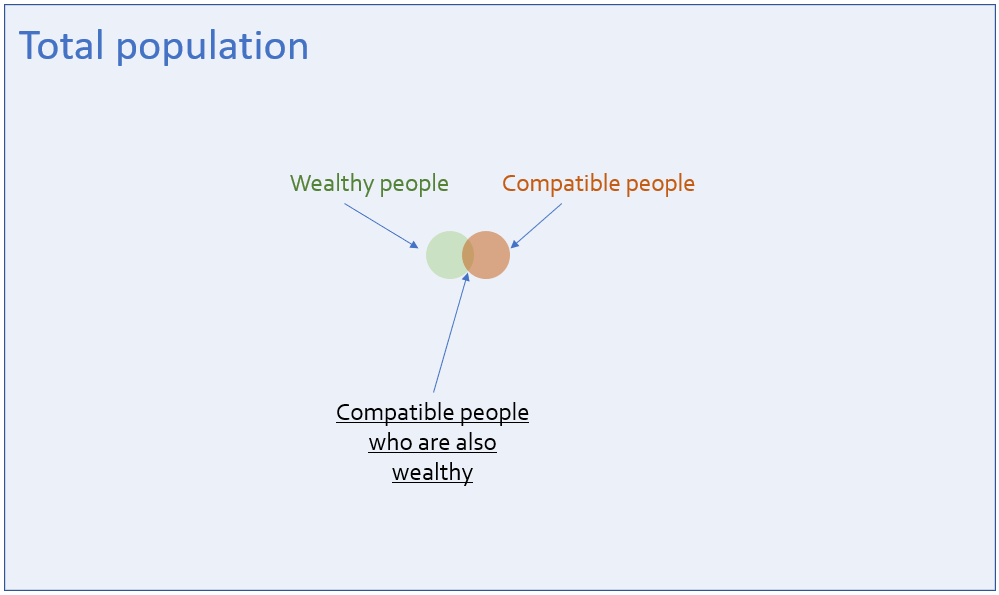
Before getting married, it’s important to follow Kotlikoff’s advice and interrogate any potential partners about significant debts or other issues that could cause financial harm over the course of your marriage. Having these sort of conversations ahead of time can build trust and improve your relationship.
#3 – Don’t borrow for college
I agree with this 100%. Borrowing for college is a recipe for disaster. Just behind divorce, excessive student loans are the biggest threat to most people’s financial well being. 40% of new college students don’t graduate. So if you start college today, you have a 2 in 5 chance of not finishing. That’s a huge risk! If you borrow lots of money for college and then drop out, you (and possibly your parents) now live in a world of financial misery.
Kotlikoff advises shopping around and focusing on the “net price” of college, or the price after including all scholarships and grants (but not loans). This can make a tremendous difference. And you don’t have to settle… as Kotlikoff says, “You can get the best of both worlds: an elite education at a dirt-cheap price.” But it requires planning ahead and being flexible and open minded.
Contrary to popular opinion, “Money Magic” also highlights that there are plenty of ways to become financially successful if you skip college. Many new hires at tech companies lack a college degree. And demand for tradespeople such as plumbers or HVAC technicians will likely be strong for… well… forever. As Kotlikoff astutely points out:
As for plumbers, their jobs seem safe. There are 120 million buildings in the US, each with its own idiosyncratic piping that isn’t in any danger of fixing itself.
“Money Magic” (page 23)
For more along this line of thinking, watch this for a good comparison between UPS drivers and doctors.
A note about doctors
Some people might say, “What if I want to become a doctor? Won’t I make enough to justify my student loans?” The answer is… maybe. If you are dead set on heading into a high paying medical specialty (think brain surgeon or dermatologist), then borrowing money to fund medical school can work. But for many doctors, prevailing compensation levels combined with a late start to career earnings will generate challenges with managing a significant debt load. It’s still possible to become a pediatrician if you have some student debt, but you will need a plan of attack to manage it.
Thankfully, with a little creativity and elbow grease, it’s possible to find ways to effectively and safely pay for college. Below are some other good resources. If you or a family member is planning to attend college in the near future (or is even attending right now), then getting familiar with these resources could save huge amounts of money:
- “Mismatch: The New Economics of Financial Aid and College Access” by Phillip Levine
- “The Price You Pay for College” by Ron Lieber
- myintuition.org
And hey, if all else fails, you can join the Army!2
#4 – Explore a wide variety of career possibilities
This is something that often doesn’t get enough emphasis for young people. Just a handful of careers tend to get the lion’s share of attention in our culture. Think doctor, lawyer, software engineer, movie star, or social media influencer. “Money Magic” sets forth a sound argument for looking further afield.
And don’t be afraid to try new things. Switching jobs frequently is often the surest path to increased compensation. By trying more things, you can also increase your chances of finding a career that you really enjoy. In fact, it’s my belief that the best companies offer their workers the chance to shift around into a wide variety roles and job titles.
#5 – Conventional investment advice is dangerous
Kotlikoff doesn’t hesitate to skewer financial advisors. Much of the investment advice peddled by financial advisors involves client’s taking on too much risk and paying too much in fees. He fairly points out that many financial advisors don’t push clients to save enough for retirement, and instead rely on the hope of high future investment growth to make up any shortfalls. This leads to many clients taking on risks that they may not fully appreciate, especially when basking in the warm light of the high market returns over the past 10 years.
The LS Cone
In “Money Magic”, Kotlikoff introduces something called the “Living Standard Cone” or “LS Cone”. This concept relies on the economic idea of consumption smoothing or trying to keep your living standard (aka discretionary spending) roughly equal or slightly better from year to year, rather than shifting up or down based on changes in the market. Basically, your LS Cone is just the probability distribution of all your possible future living standards3.
Kotlikoff’s main advice for your LS Cone is 3 fold: move it up, tilt it up, and narrow it. How do you do each of those?
If you want to raise your LS Cone, you follow standard personal finance advice. Earn more. Retire later. Reduce investment fees and taxes. Nothing too groundbreaking there.
If you want to tilt your LS Cone up (basically improving the “worst case” scenario), then you spend frugally and cautiously. Again, not groundbreaking.
And to narrow your LS Cone, you remove risk from your life. Pay off any debt (as we already covered). And invest in a more risk-averse way. Kotlikoff highly recommends a downside protection investment approach, which mainly relies on investing enough assets in inflation protected bonds such as TIPS or I Bonds so that you can meet your basic needs. Then any remaining assets can be invested in risky assets such as stocks.
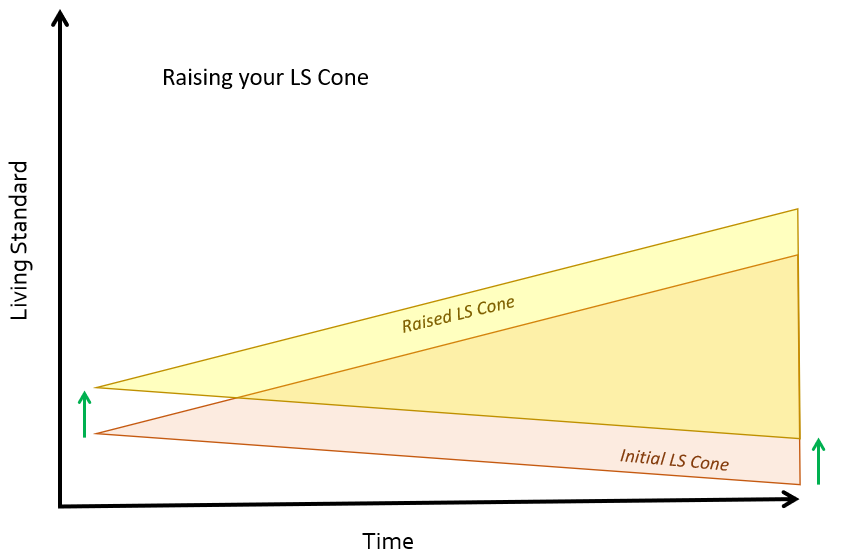
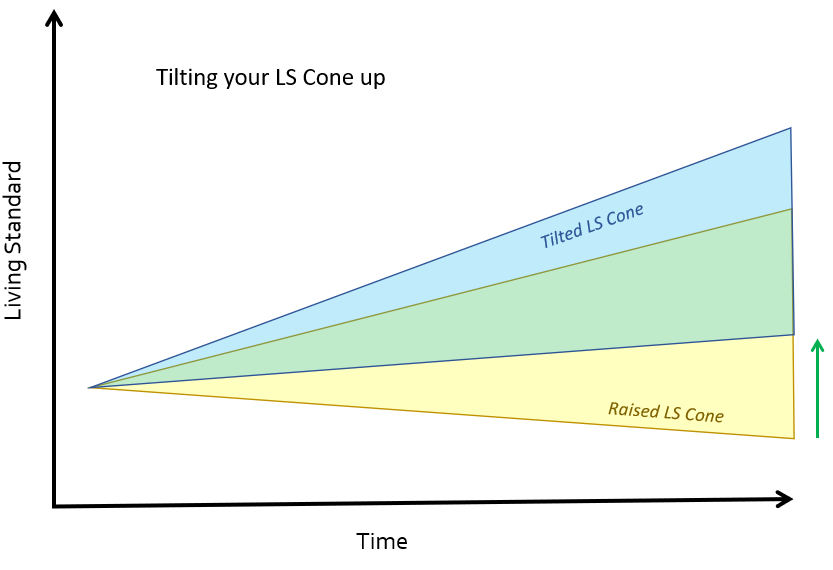
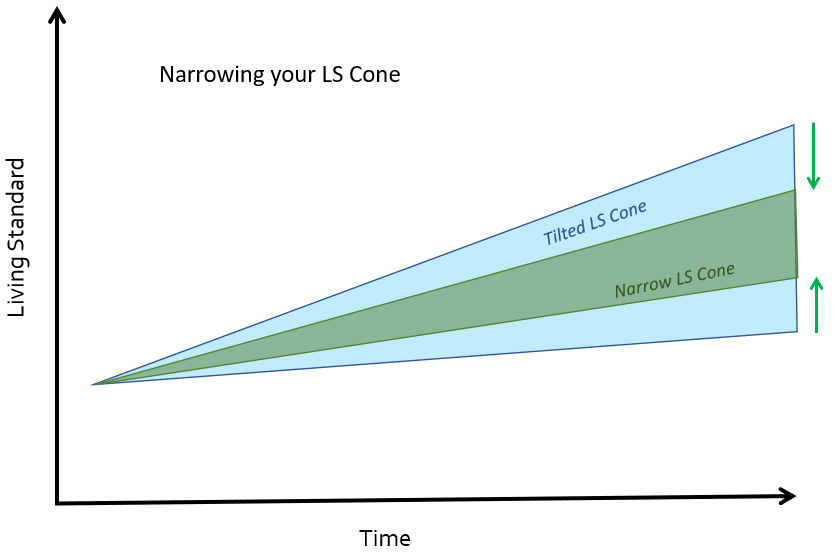
#6 – Don’t mess up Social Security (or let them mess you up)
Kotlikoff is the godfather of smart strategies for Social Security. And he offers plenty of solid advice in “Money Magic”. The most important piece of advice? Delay claiming your benefits for as long as possible (but in no case should you wait past age 70).
Kotlikoff even advises in “Money Magic” that you spend down any pre-tax retirement assets to avoid claiming Social Security benefits early. Many advisors (especially those who charge an asset based fee), would balk at this idea. But it’s sound advice.
The US Government offers a tremendous deal to retirees who can wait (ideally until age 70) before claiming benefits. And if you spend down pre-tax retirement assets before claiming benefits, you can take advantage of lower marginal tax brackets and avoid taxes on your Social Security benefits during those early retirement years. And you will also reduce the amount of fees paid to your financial advisor!
Deferring Social Security benefits won’t be best for everyone. But even in the worst case where you have a terminal illness, there are still cases where deferring can make sense (such as increasing benefits for your spouse).
Another bit of Kotlikoff’s money magic? Watch your back when dealing with the Social Security Administration. Social Security is a complex system with a deep, dark labyrinth of rules and regulations that few people fully understand, and that includes the folks that work at the SSA. Shop around at different SSA offices if you don’t get a favorable answer to your question. And always document your dealings with the SSA. Take a picture or save copies of any applications, and don’t be afraid to note down your intentions in the remarks section of any applications.
The folks at the SSA are great people who try their very best. But it’s important to stay skeptical and do your research to get your optimal benefit.
A special note on widow(er) benefits
The SSA has been giving terrible advice to people applying for widow(er) benefits. Generally, the SSA will encourage simultaneous application for both widow(er) and retirement benefits. But this is often a terrible idea. If you are a widow(er) and approaching retirement, you have the option to apply for widow(er) benefits separately from retirement benefits. So you have a chance to sequence the benefits for maximum effect. Generally, you’ll want to claim the smaller benefit first, and let the larger benefit grow to its maximum amount. But when exactly that occurs depends on a complex set of factors. Consider using a software program to help analyze everything.
Final Thoughts
Overall, “Money Magic” was a great book. It offers some unconventional and fresh thinking, which is often hard to find in personal finance circles. I wouldn’t say Kotlikoff offers anything revolutionary. But he does a good job of highlighting important areas where it is possible to improve your financial life. And to do so without a lot of effort.
1 It’s important to note that I’ve ignored the cost of debt in this example. And debt is certainly not free. This is the reason credit card debt is so pernicious. Not only does it add risk to your finances, but it also costs a fortune in the form of sky high interest rates!
3 If you’re interested, Kotlikoff breaks down a method to calculate your LS Cone using Monte Carlo simulation in the book.

